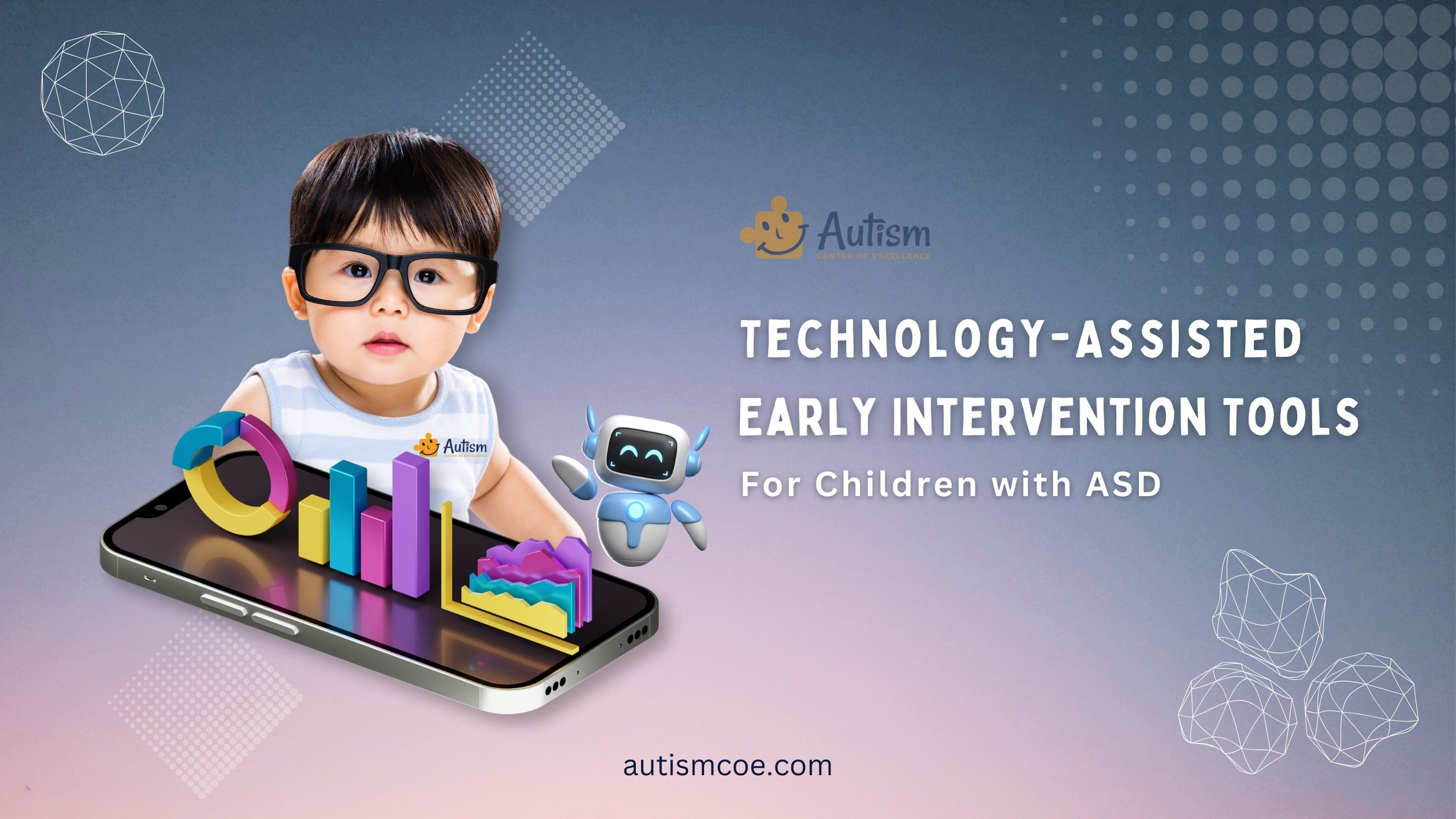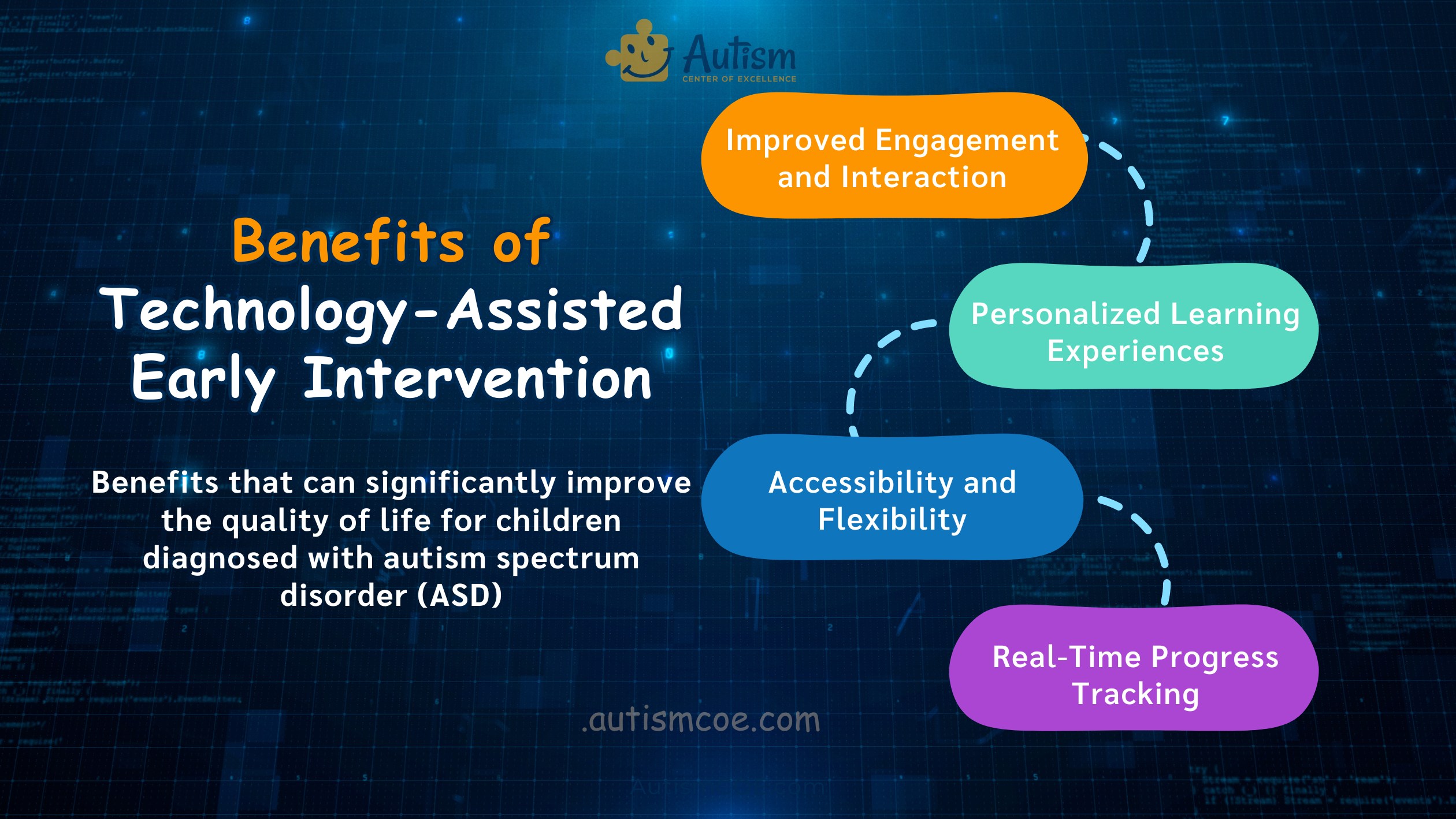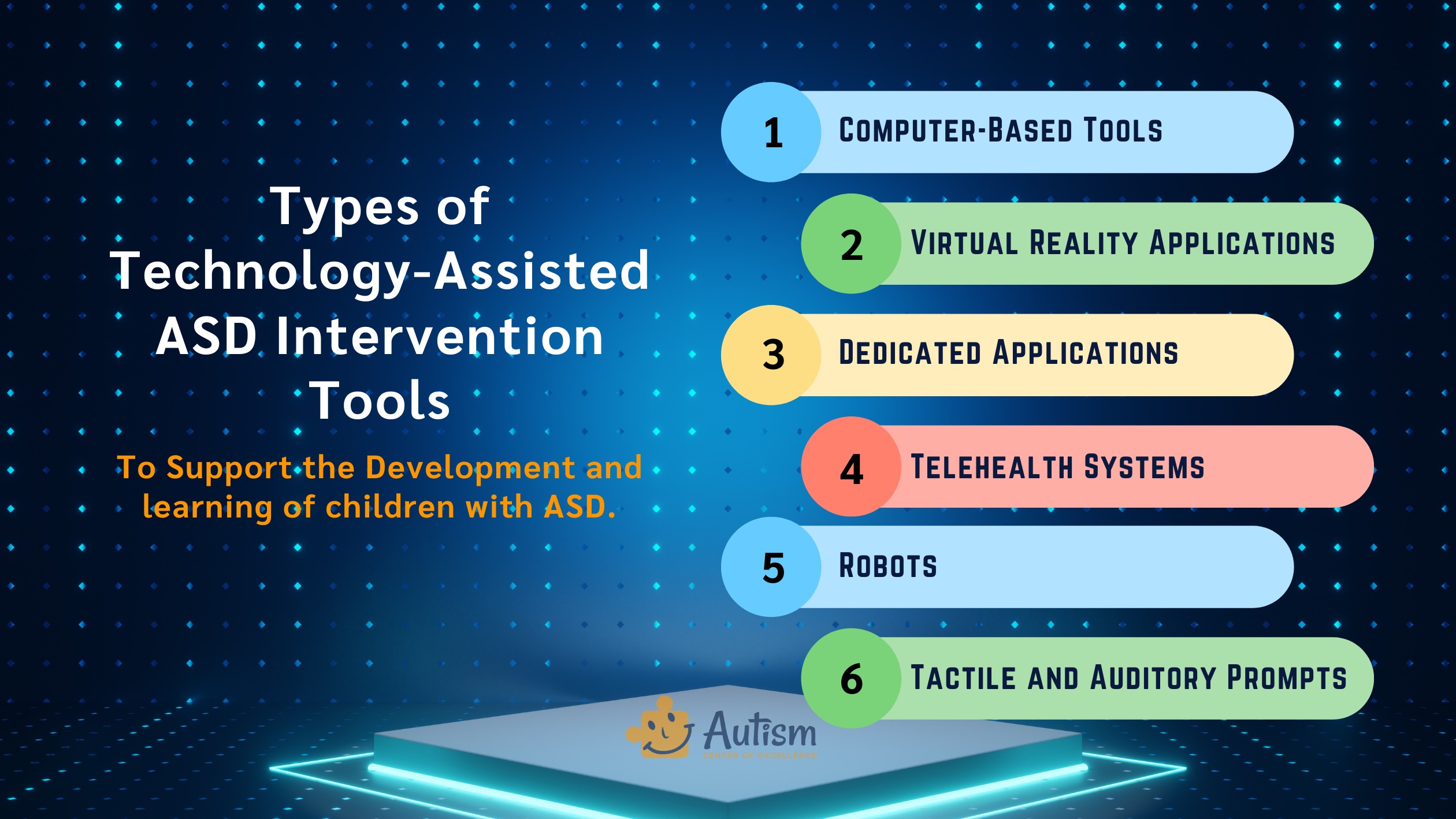Unit 18: Technology-Assisted Early Intervention Tools for Children with ASD

Early intervention tools with the assistance of technology are playing a transformational role, especially in the realm of Autism Spectrum Disorder (ASD) in the continuously changing face of healthcare. These creative aids, ranging from telehealth interventions to AI-powered assistance apps, are changing the course of autism therapy. The current blog post will discuss the different aspects of technology-assisted autism interventions and the ways the Early Intervention assistive technology is bringing a huge amount of relief into the lives of autistic children. The part of the virtual reality in Autism Treatment, the advantages of e-learning for autistic children, and the effect of tech-based interventions will be reviewed. This article presents a complete picture of the recent developments in ASD intervention materials.
What is Technology Assisted Early Intervention?
Technology-Assisted Early Intervention is the application of technological resources including digital tools and devices to support early detection, diagnosis, and treatment strategies of a wide range of physical and developmental conditions in children. This method uses state-of-the-art technologies like Artificial Intelligence, Machine Learning, Augmented Reality, Mobile applications, and Autism Support apps among others to help in the Early Intervention Process. The tools are made to detect developmental delays or disorders before they develop in children so that the child has as many chances to grow and develop as possible for all healthcare practitioners, educators, parents, and caregivers.
Interventions based on technology for children with ASD are critical in autism therapy. ASD has often been recognized in early childhood and early intervention can dramatically improve a child’s prognosis. Technology allows professionals to deliver individualized, interactive, and fun therapeutic activities. Some of these intervention tools for ASD will also allow for continuous monitoring, and this data can be used to measure progress and adjust Early Intervention Strategies as required. Such a combination of technology and early intervention creates a hopeful picture for most children’s situations in the spectrum.

Benefits of Technology-Assisted Early Intervention
Technology-Assisted Early Intervention has many advantages that can greatly enhance the life of children with Autism Spectrum Disorder (ASD). Here are some of the key advantages:
🌟 Improved Engagement and Interaction
The gamified approach is mostly used in digital tools, with interactive elements, but it holds the child’s attention better than traditional way of learning. This increased interaction, which results in the intervention being the more enjoyable for the child promotes better interaction. The children who are suffering from ASD and who usually have problems with Social Interactions, this innovative ASD intervention is a very important way of developing such skills in a relaxed and pressure-free environment.
🌟 Personalized Learning Experiences
Each child is different, particularly in terms of learning style and learning speed. Technology-Assisted Early Intervention tools permit customization, wherein the intervention strategies can be modified to fit the unique requirements and abilities of every child. This way, the child is not either overactive or passive, but rather always challenged at a suitable level.
🌟 Accessibility and Flexibility
One of the main benefits of the use of assistive technology for autism is its provision of accessibility and flexibility. Digital tools can be employed at any place and at any time, eliminating the factors of place and time. By this, children and their caregivers can conduct Therapeutic Activities at the time and place that suits them best and that consistent intervention is now more feasible.
🌟 Real-Time Progress Tracking
Finally, technology supported instruments allow the advantage of real-time progress tracking. Continuous data collection can be done by these tools and they provide good information on the development of the child and the way he or she responds to the intervention. This enables the healthcare providers and caregivers to closely monitor the progress, change tactics as required, and evaluate which approach is the most effective. Such a data-driven approach can dramatically improve the success of early intervention strategies.

Types of Technology-Assisted ASD Intervention Tools
There are different technological tools utilized in early intervention for Autism Spectrum Disorder (ASD). Various forms and different purposes are inherent in these tools, but all of them strive to Approve the Development and learning of children with ASD.
1. Computer-Based Tools
The computerized tools are the software programs that provide a lot of interactive activities that are aimed at improving social, cognitive, and motor skills. They are very adjustable and can be modified according to the needs and abilities of the child.
2. Virtual Reality Applications
Virtual Reality (VR) applications provide environments, which are highly realistic and in which children with ASD are able to develop social interaction and other skills in safety and under control. Such applications are capable of modeling real-life situations that offer a realistic but flexible environment for learning and development.
3. Dedicated Applications
Several dedicated applications are specifically designed for ASD intervention:
Educational Apps Tailored for ASD
These apps provide organized learning activities, tailored to the specific needs and learning styles of children with ASD. They usually contain visual aids, simple directions, and consistent schedules for creating a comfortable learning setting.
Augmented Reality Applications
Augmented reality (AR) merges real-world environments with digital elements, providing a vibrant and interactive learning platform. Children with ASD can use AR apps to improve their social skills, communication, and problem-solving skills.
Speech and Language Therapy Apps
These apps focus on Improving Speech and Language Skills. They offer a range of activities, from basic sound production to complex sentence formation, making them suitable for children at various stages of language development.
4. Telehealth Systems
With telehealth systems, healthcare providers can carry out remote assessments and interventions. This is especially advantageous for people living in rural areas and those with restricted services.
5. Robots
Robotic social mediators can be utilized to assist children who have ASD to acquire proper social and communication capabilities. They can play games with the child, Model Appropriate Social Behaviors, and give ongoing feedback.
6. Tactile and Auditory Prompts
Tactile and auditory prompts include the references to touch or sound that direct one’s activity or attention to particular activity. These can be exceptionally helpful for the children with ASD, who suffer from Sensory Sensitivities or attention difficulties.
Join Our Weekly Newsletters!
Subscribe now to stay updated with our latest email updates.
Considerations for Parents and Educators
Some Important Considerations for Parents and educators include the use of technology-assisted tools in the early intervention process for Autism Spectrum Disorder (ASD). These things include selecting appropriate tools, putting these tools into the daily routine, and working with the professionals for implementation.
☑️ Guidance on Selecting Appropriate Tools
Proper technology-assisted tool selection is very important. In this decision, parents and educators need to take into account the age of the child, developmental level, interests, and specific difficulties. Researching the tools, comparing them, reading reviews, and asking a professional would be good. Ease of use of the tool, customization options, and the sort of data it provides for tracking progress should also be taken into account.
☑️ Tips for Integrating Technology into Daily Routines
Consistency is Key to Successful Early Intervention, and integrating the use of technology into a child’s daily routine can help to achieve this. Start by presenting the tool when the child is in the learning mode. Begin to use more as the child gains more confidence in the tool. Technology should be used to meet other needs and it should be balanced with physical play and social activities to avoid child development through a lopsided approach.
☑️ Collaboration with Professionals for Effective Implementation
Partnership with professionals including therapists, special education teachers, and pediatricians is important to the efficient deployment of technology-assisted instruments. These specialists can offer significant input concerning the optimal ways of using these tools to promote the development of a child. They can also assist in tracking the progress of the child and modify Intervention Strategies when required. An uninterrupted flow of information among parents, educators, and professionals is important for proper viewing of the child’s needs and the effectiveness of interventions.

Popular Technology-Assisted Tools for ASD Intervention
Autism-friendly learning tools are among the most popular and innovative technology-assisted approaches for the intervention of ASD. The applications of technology-oriented intervention tools in early intervention have been associated with significant communicative, behavioral, and Academic Skill improvements in persons with ASD.
1️⃣ Proloquo2Go
This is a complex Augmentative and Alternative Communication (AAC) app that is a voice for people who can not speak. It is user-friendly, customizable, and appropriate for all ages and skill levels.
2️⃣ Brain Power
This is a mobile system that trains social and cognitive skills through games and activities. It utilizes Google Glass technology to deliver instant coaching in social situations.
3️⃣ Otsimo
It is an educational app with a variety of games to develop different skills such as motor skills, cognitive skills, and language skills. It is custom-made, child-oriented, and user-friendly.
4️⃣ Milo the Robot
This humanoid robot helps children with ASD practice social interactions and emotional understanding. Milo delivers lessons in a fun, engaging manner and provides consistent feedback.
5️⃣ Autism Therapy with MITA
This application deals with mental integration and language growth. It utilizes puzzles grounded on the Pivotal Response Treatment method, which is one of the most successful therapeutic techniques for Children with ASD.
6️⃣ SuperSpeak Play
This AAC app allows children to communicate their needs by playing related images. It’s intuitive, visually appealing, and can be customized to suit the child’s individual needs.
7️⃣ Avaz
The AAC app is meant to help non-verbal children and patients with Speech Difficulties. It provides a wide diversity of words, options to customize, as well as user-friendly features.
8️⃣ Model Me Going Places
This app uses visual narratives to help children understand and navigate various social situations. It’s simple, straightforward, and can be a valuable tool for teaching social skills.
9️⃣ Tobii Dynavox
This is a suite of AAC solutions that includes both hardware and software. It offers eye-tracking technology, making it suitable for children with severe physical limitations.
🔟 Choiceworks
This application aids children in comprehending and observing daily routines, controlling emotions, exercising patience, and decision-making. It is versatile, easy to personalize, and features an image gallery.
Future Trends in Technology-Assisted Interventions
The next several years will bring a great rise in the utilization of technology-supported digital tools for Autism Interventions, especially in health and rehabilitation areas.
The next trend is the incorporation of smart home and wearable technology with healthcare solutions. They provide novel solutions for remote surveillance and intervention, which may help manage Autism Spectrum Disorder (ASD) among others.
For instance, wearable devices might monitor physiological or behavioral markers of ASD, and offer instant feedback and reinforcement. We also expect more technology investment throughout the healthcare sector, which should result in the development of more innovative and efficient technology-assisted interventions.

ASD and AI Technology
The role of Artificial Intelligence (AI) in this transformation is expected to be quite substantial. The ability of AI to process huge volumes of data and identify patterns may be beneficial in the development of Individualized Intervention Principles. In addition, AI algorithms have been demonstrated to enhance the precision of Assessment Instruments and, hence, assist professionals in making better decisions concerning diagnosis and intervention strategies.
Frequently Asked Questions & Answer
What is AAC Device for Autism?
AAC (Augmentative and Alternative Communication) devices are designed to help individuals with ASD who have problems with speech communication communicate. Some of such devices are non-electronic such as picture boards, and audio such as speech-generating devices. The mobile apps that convert text into voice are also popular AAC devices. These instruments are important for improving the communication skills of those with ASD, and hence, their social relationships and quality of life.
What are the Speech Therapy Apps for ASD?
ASD speech therapy apps are digital solutions developed to enhance speech and communication abilities in those affected by Autism Spectrum Disorder. Such apps as Proloquo2Go, and Articulation Station employ interactive exercises, visual aids, and customized drills to assist ASD individuals in communicating more efficiently.
What are ASD-Specific Screening Tools?
ASD-specific screening tools are assessment tools applied by health professionals to detect symptoms of Autism Spectrum Disorder in people, especially, in their early years. Other examples encompass the Modified Checklist for Autism in Toddlers (M-CHAT), the Autism Diagnostic Observation Schedule (ADOS), and the Autism Diagnostic Interview-Revised (ADI-R).
What are Examples of Assistive Technology for ASD?
The assistive technology of ASD consists of various tools that are created to help people with autism to lead their daily lives. Some of these are communication apps such as Proloquo2Go, which help non-verbal individuals with ASD to communicate their needs and ideas. There are also sensory-driven apps such as Endless Alphabet used in learning and cognitive development. Other technologies involve wearables that monitor physiological responses and offer biofeedback.
Conclusion
Technology-assisted interventions are beginning a brand new era of early intervention for children with ASD. Between virtual reality and AI, mobile applications, and adaptive learning tools, these solutions do not just mean the new face of Autism Therapy is beginning to emerge, but also the kids suffering from autism are given a chance to reach their full potential. Technology in the treatment of autism offers several advantages, such as individualistic learning experiences, better accessibility, and improved participation. With its ability to leverage technology, the future presents a promising picture for more innovation in ASD interventions by AutismCOE. The autism spectrum disorder technology field is now in an exciting age, and we are eager to delve into what comes next on this amazing journey.
Please Note: The content of this blog is for informational purposes only and should not be considered a substitute for professional medical advice, diagnosis, or treatment. Consult a qualified healthcare professional for personalized guidance tailored to your specific situation.

Bhavika Bhasin
Bhavika Bhasin is the Research and Marketing officer at AutismCOE. She works with children and adults with ASD. Her clinical research includes evaluating various available autism screening and diagnosis methods and their efficacy. She is currently developing a novel screening exam that is indicated to be more accurate than the existing available exams. She is also writes articles papers for various publications.

